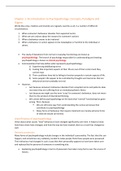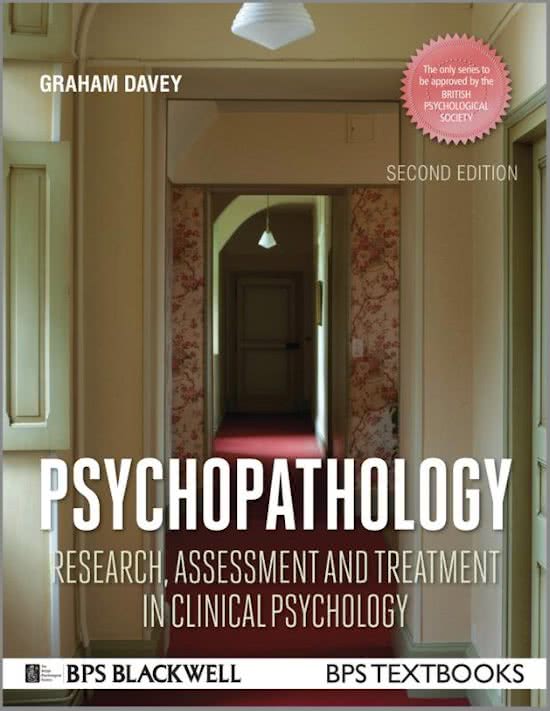Chapter 1: An introduction to Psychopathology: Concepts, Paradigms and
Stigma
Words like crazy, madness and insanity are regularly used by us all, in a number of different
circumstances:
1. When someone’s behaviour deviates from expected norms
2. When we are unclear about the reasons for someone’s actions
3. When a behaviour seems to be irrational
4. When a behaviour or action appears to be maladaptive or harmful to the individual or
others.
• The study of deviations from normal or everyday functioning are known as
psychopathology. The branch of psychology responsible for understanding and treating
psychopathology is known as clinical psychology.
• Commonalities that help define what represents psychopathology:
1) Experiencing debilitating stress
2) Feeling that important aspects of their life are out of their control and they
cannot cope
3) Their conditions have led to failing to function properly in certain aspects of life.
4) Some people’s life appear to be controlled by thoughts and memories that are
delusional and are probably not real.
• However,
o Just because someone’s behaviour deviates from accepted norms and patterns does
not mean they are suffering from an mental/psychiatric illness
o Just because we might use the term ‘crazy’ for someone’s behaviour, does not mean
that it is the product of disordered thinking.
o We cannot define psychopathology on the basis that “normal” functioning has gone
wrong. This is because
▪ We are still some way from understanding the various processes that
contribute to psychopathology
▪ Many forms of behaviour that require treatment are merely extreme forms
of what we would call normal.
A brief history of psychopathology
Views about what causes “mad” behaviours have changed significantly over time. It helps to know
how these views have changed, and how the way we have treated client as a result has changed as
well.
Demonic possession
Many forms of psychopathology include changes in the individual’s personality. The fact that this can
happen, and sometimes very suddenly, tended to make people think these people were possessed.
Their behaviour had changed in such a way that their personality appears to have been taken over
and replaced by the persona of someone or something else.
• Explaining psychopathology in terms of possession has taken many forms over the course of
history
, o Many sufferers of psychopathology have been persecuted and physically abused
because of this, instead of being offered the support and treatment they needed.
• Ancient civilizations such as those in Egypt, China, Babylon and Greece, believed that those
exhibiting symptoms of psychopathology were possessed by bad spirits (demonology).
o The only way to get rid of these spirits was through ceremonies that often involved
direct physical attacks on the sufferer’s body.
➔ This usually increased distress and suffering.
• It remained a common explanation in Western societies up until the 18th century
o Witchcraft
o Demonic possession
• In contrast, in the Middle Ages in England, a lunacy trial would be held, and if a person was
found to be insane they would be given protection of the law.
• Still a common explanation for psychopathology in less developed areas
o Often linked to religious beliefs
o Often accompanied with exorcisms, even with a knowns history of diagnosed
psychotic symptoms!
The medical or disease model
• As we began to understand some of the biological causes of physical diseases, our
conception of “madness” very slowly moved towards treating it as a disease as well (19th
century)
• It was discovered that syphilis had a biological cause, and was also an important contributor
to the mental disorder general paresis (dementia, progressive muscular weakness and
paralysis)
→This implied that many other examples of mental illnesses might have a medical
or biological explanations too = somatogenic hypothesis
• This was an important development as it introduced scientific thinking in psychopathology.
The medical model gave rise to a large body of scientific knowledge about psychopathology
that is based on medicine. This is known as psychiatry.
Primary approach of the medical model: to identify the biological causes of psychopathology, and to
treat them with medication or surgery.
➔ While biological factors may play a role in the aetiology of some psychopathologies, these
explanations are not the only way in which psychopathology can be explained, nor is
biological dysfunction necessarily a factor underlying all psychopathology.
• Implications of the medical model:
1- It implies that medical or biological causes underlie psychopathology. Bizarre
behaviour can be developed by perfectly normal learning processes. Also,
dysfunctional experiences an individual has can lead them to thinking or
acting in another way.
2- It attempts to reduce complex psychological and emotional features of
psychopathology to simple biology.
3- It is assumed that psychopathology is caused by something “not working
properly”. This is problematic because
a. Rather than it being a dysfunction, it might just be a more extreme
form of normal behaviour.
b. This might influence the way we view people suffering from mental
health issues and even how they view themselves. It leads to
, stigmatizing and labelling and sufferers are even viewed as second-
class citizens.
From asylums to community care
• Many hospices for diseases as infections such as leprosy, in the 18th century, were converted
into asylums for the confinement of individuals with mental health problems.
o No coordinated government rules until the 19th century. Life in the individual
privately funded madhouses was cruel and inhumane.
o Primarily established for business profit. They took in more and more sufferers.
o Medical treatment provided was often painful
o Individuals from poor backgrounds were taken in as well – a big mix of inmates.
Combating moral degeneration and social weakness was the goal.
➔ This may be the cause for the modern-day stigma surrounding
mental health problems.
• A gradual movement towards more humane treatment for individuals in asylums in the 19th
century. Pioneers:
o Philippe Pinel. Began by removing chains and restraints. Started treating inmates as
sick human beings rather than animals.
o Benjamin Rush
o The Quaker movement (UK). Developed moral treatment: replaced contemporary
medical approaches with understanding, hope, moral responsibility and
occupational therapy.
• Even up until the 1970s in both the UK and the USA hospitalization was the norm for
individuals with severe mental health problems.
• Between 1950-1970, limitations of hospitalization were being recognized and attempts were
made to structure the hospital environment.
o Milieu therapies: the first attempts to create a therapeutic community on the ward
which would develop productivity, independence, responsibility and feelings of self-
respect.
▪ Mutual respect between staff and patients
▪ The opportunity for patients to become involved in vocational and
recreational activities.
▪ Patients, as a result, were more likely to be discharged sooner and less likely
to experience a relapse.
o Token economy programmes: based on operant reinforcement. Patients would
receive tokens for desired behaviours (social and self-help behaviours) and tokens
could be exchanged for rewards like chocolate, cigarettes and hospital privileges.
o Also sooner discharge of hospitals, and even more effective than milieu therapies.
• Less use of hospitalization. It is still being used in severe cases but the time spent in them is
also reduced due to more effective early intervention programmes, supportive community
care and outreach programmes.
• In 1963, the US congress passed a Community Mental Health Act people with mental health
problems had the right to receive a broad range of services in their communities, rather than
be detained and treated in hospitals. Many countries followed this movement!
, Defining psychopathology
• As psychological problems often do not have underlying physical or biological causes and as
knowledge of many psychopathologies is still in its infancy, we are not yet in a position to
have a classification of psychopathologies based on causal factors.
➔ This leads to trying to define psychopathology in ways that are
independent of the possible causes of the problems, which leads to
other implications.
• Many text books use the title abnormal psychology, which implies that sufferers are
abnormal in either statistical or functional terms, or they are inferior members of society.
• Service user groups are an example of people who have become they and other mentally ill
people are being labelled and perceived by others.
Deviation from the statistical norm
• Deviations from the statistical norms have been used to decide whether a particular disorder
meets diagnostic criteria (for example a score below 70 is seen as a low IQ)
• There are some problems with this:
o Rather than forcing someone in a diagnostic category, a better approach would be
to evaluate the specific needs of individuals with (as in the example) intellectual
disabilities.
o It does not necessarily imply psychopathology, because people with exceptionally
high IQs are also statistically rare. But these individuals are not quickly considered to
be candidates for psychological interventions. Adopting the statistical view on
defining psychopathology, doesn’t make us objective in this sense.
• Emotions such as anxiety and depression are not statistically rare emotions, but experienced
daily by most people.
Deviation from social and political norms
• We assume that socially normal and acceptable behaviours have evolved to represent
adaptive ways of behaving, and that anyone who deviates from these norms is exhibiting
psychopathology.
• Cultures differ significantly in what they consider to be socially normal.
• It is difficult to use cultural norms to define psychopathology because cultural factors seem
to affect psychopathology in and of itself.
Maladaptive behaviour and harmful dysfunction
• In its extreme form, maladaptive behaviour might involve behaving in a way that is a threat
to the health and well-being of the individual and to others.
o Some criminals might exhibit this type of behaviour, but they will not all have a
psychological disorder.
• Deficits in social, occupational and educational function are a criterion for defining many
psychological disorders (in the DSM-5)
• Assumption of Wakefield, harmful dysfunction: assumes that psychopathology is defined by
the dysfunction of a normal process that has the consequence of being in some way
harmful.
o It is hard to know what ‘normal’ process might by dysfunctional, because we do not
know enough about ‘normal’ brain functioning.






